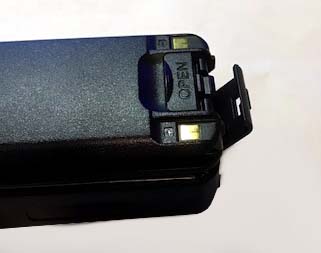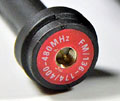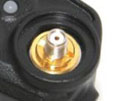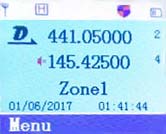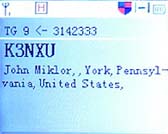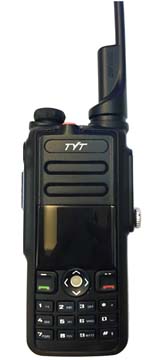Product Review
TYT MD-2017
Dual Band
DMR Handheld
TDMA Tier I / II
VHF / UHF
June 2017
Rev. July 2017

|
MD-2017
The TYT MD-2017 is a true Dual Band band (UHF / VHF) DMR handheld that can be used as either an FM analog transceiver or Tier II DMR digital. In the Box Included with the radio are the: - 2200mAh Li-Ion Battery - 73 page User Guide – English - Charger base & AC adapter - Belt clip - Antenna – 6" (15cm) - Driver and Software CD - Programming Cable General Description - VHF / UHF Dual Band - DMR / FM - 1W / 5W transmit - 3000 channel - 100,000 contacts Dual Band Operation This is obviously the radio's biggest advantage, but please read the entire review. When programming the zones for this radio, there are two sets of 64 channels for each zone. 64 channels for the upper display, and 64 for the lower. My configuration is for DMR UHF on one display, and the local VHF analog on the other. When a channel becomes active, that channel is selected and remains selected until clear. Transmitter The frequency range is both VHF 136-174 and UHF 400-480 MHz. Along with DMR, the radio also supports FM, both Wide and Narrowband and is FCC Part 90 certified. OTA audio reports are excellent and power levels on analog were respectable. Rated at 5W, the radios put out closer to 4W on the ham bands into a calibrated Bird Termaline wattmeter.
Receiver
The receiver sensitivity is very good on both digital and analog. I found the audio quality is clear, loud, and undistorted. The radio has the characteristic tone option that will let you know the signal has dropped. Audio The audio is full and loud with excellent frequency response. The major advantage of DMR is the audio quality. Noisy signals no longer exist. If a signal has enough strength to be heard by the receiver, it is digitally processed where all noise is eliminated and what would be a noisy signal on FM now sounds as though the person is standing right next to you. Enclosure The MD-2017 case has a solid feel, weight, and durability that gives the impression that if the radio is dropped, the concrete would crack before the case would. It weighs in at a hefty 10.2 oz (289g) with the battery attached. The battery removal design makes battery replacement quick and easy. A slight pull on the Open tab releases the latch on the bottom and the battery slides off very smoothly. I do have a concern about the durability of the hinged clip. If the radio is dropped and the clip fractures, the case has no way of holding the battery in place.
Trackball Here's a new "feature" that I really question. I found it slow responding and inconsistent. When I swipe left/right, it changes channel at a rate of one channel per second, periodically changing too far. Changing channels while driving can be more of a distraction than texting. I tried once and never again. I also found that if I lift the radio and my hand touches the trackball, there's a good chance I just changed the channel.
The included dual band antenna is 6" which is a fairly common size for a handheld. The wider base helps with the waterproofing properties of the radio. Although the standard antenna seemed to do a respectable job, using the RSSI reading from a UHF repeater 15 miles up the road, I found that there was a very noticeable improvement by using an upgraded antenna. If you are close enough to your local repeater, I would use the stock antenna, but if you're on the fringe, you may want an upgrade.
The antenna base design is much wider than a standard antenna, and you can feel the solid waterproof seal when tightening which also adds additional stability to the antenna. Be cautious, however, if using a replacement antenna. The connector on the radio is a bit longer than most and a different antenna may not screw all the way to the base. This could fracture the connector if the replacement antenna meets with a heavy impact. If the new antenna does not screw down to the base, a grommet or spacer is recommended.
Update: Unfortunately, several stations have reported that the above concern has become reality. The connector has fractured under stress. Display The radio has a multicolor display. The main background is a sky blue with multicolor icons. The screen size is 1.1" x 1.4" with excellent resolution .
If you are entering the world of DMR for the first time, be aware that programming a digital radio is a lot different than an FM transceiver. Although the FM side is similar, the digital side requires a bit more in depth knowledge. I recommend that you find someone in your area that can help by supplying an initial template to start you on the right path. I've done data images (a.k.a. code plugs) for several radios over the past years and although the software may vary, the basic code plug procedure is the same for most. Software This radio can be programmed via the front panel, but this is not for the faint of heart. The factory software is fairly straight forward, but again, contains terminology that may require a bit of research. A little intimidating at first, but call it a basic learning experience. Firmware The MD-2017 was introduced in the US in May 2017, and the TYT factory firmware is fully upgradable, so you will always have availability to the latest version. The firmware upgrades can be done with a Windows computer in about 5 minutes. Programming Cable The programming cable is a bit unique but helps with the waterproofing capabilities of the radio. The UART chip is in the radio, not the cable. When the cable was plugged into my PC, the proper driver loaded automatically.
I was a bit disappointed with the life of the battery. I turn my radio on in the morning around 8AM. By 7-8PM, the battery was ready for a recharge. This was with the LCD off and No transmitting. I checked the manual and apparently this is expected. The radio draws 180mAh on standby. This is a bit high as many transceivers only draw about 75mAh. 2200mAh battery / 180mAh standby = 12.2 hours. The 2017 draws 1.6A when transmitting analog and 900mAh DMR which will reduce battery life additionally. My recommendation is to run low power and purchase a spare battery to take you through the entire day. The charger base itself requires a standard 12vdc wall wart (included). The LED bar on the front of the charger is unmistakable. Red when charging, and Green when either fully charged or no radio in the cradle. Conclusion For TYT's first attempt at a dual band digital transceiver, I think they did a pretty good job. The obvious pros are the following: - True Tier II DMR - Dual Band VHF / UHF operation - 100,000 contact User DB My personal concerns are the: - Trackball - PTT pressure The MD-2017 is solidly built, but with a few minor concerns. There are plenty of options geared more for hams than commercial use. It performs well and makes a nice addition to the ham shack. Note: This equipment was received for the purpose of a fair and unbiased review. All findings are factual based on the equipment I received. Any issues found have been reported both here and back to the seller or manufacturer.
|
BTECH 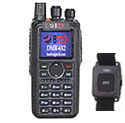 DMR6X2 PRO Dual Band (Review) Anytone 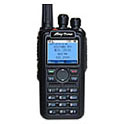 D878UV II+ Dual Band (Review)  D578UV Series Mobiles Hotspot  SkyBridge MAX (Review) Ailunce 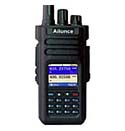 HD1 / GPS (Review) Amplifiers  BTECH DMR Amps UHF VHF (Review) Repeaters  Ham / GMRS Commercial Repeaters Duplexers |
